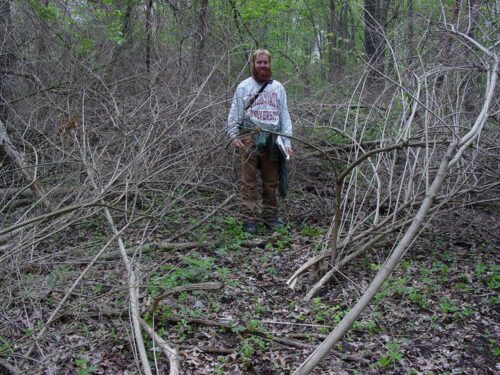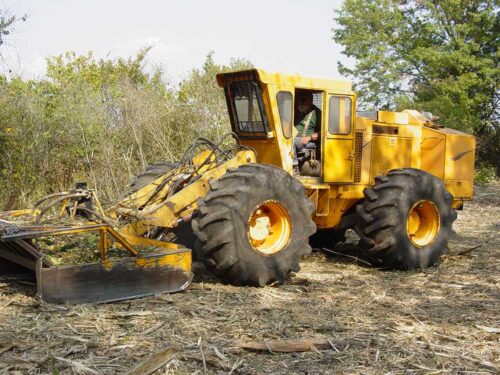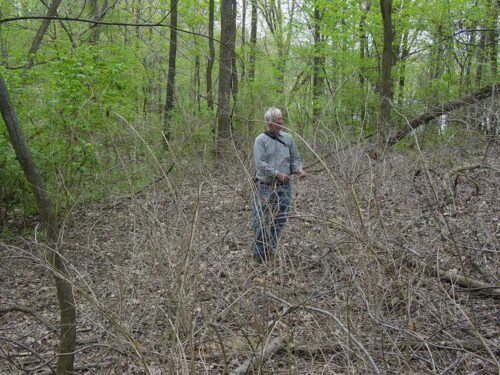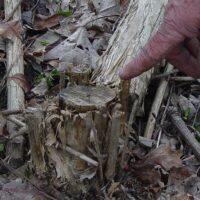 Purdue University - Extension - Forestry and Natural Resources
Purdue University - Extension - Forestry and Natural Resources
Got Nature? Blog
Question: Once I’ve pulled or cut, and have treated the bush honeysuckle stumps, can it be left to decay, particularly if not piled directly on the ground in a woodland?
When deciding what methods to use to control invasive brush on your property, one of the questions often asked is “what should I do with the cut tops?” (Fig. 1) A similar question we often get from landowners planning to have timber harvested from their woods is “what should I or the loggers do with the tree tops that are left?” The simple answer is just leave them where they are and they will decay over time and gradually disappear. If you have many acres to treat for invasive brush infestation, then this is good news. But there may be other factors to consider. In this blog post I will try to unpack those other considerations to help you decide what to do.To start let’s do a quick review of the more common methods of controlling invasive brush and the resulting ground conditions left in their aftermath. By invasive brush, I am primarily talking about non-native brush species that have invaded our native habitats, including the woods, and that are wreaking ecological havoc and degrading the productive potential of those lands for wildlife, timber, and recreation. The more common species include Asian bush honeysuckle, autumn olive, multiflora rose and callery pear (aka Bradford, Cleveland, ornamental pear).There are a variety of methods, tools, equipment, and chemicals used for invasive brush control. Other blog posts cover many of these methods, so I will not describe their use except to show what a site looks like in their wake. Large equipment like skid steer mounted mulchers or brush cutters or the industrial size Hydroax (Fig. 2) thoroughly chop up or mulch all that brush material and leave a fairly clean site (Fig. 3). In this case, there are no brush tops to dispose of. If you are wanting a very “clean” site, then hiring a dozer may be what you’re after. All those tops can then be piled and burned. The bare soil can then be planted in desired vegetation.Most forest landowners are going to use smaller scale methods and equipment, especially in the woods. Spraying herbicide on the foliage (Fig. 4) or applying it as a basal bark application to the lower stems leaves dead standing shrubs. Using brushsaws and chainsaws to cut the shrubs close to the ground and then applying a concentrated herbicide to the stump (commonly called cut-stump treatment, Fig. 5) leaves severed brush tops lying about. Even the less conventional prescribed fire will almost always leave standing dead shrub tops.

Figure 3. Once dominated by large non-native bush honeysuckle shrubs, this site was recently cleared by large brush cutting equipment. (click to enlarge)
For many people, the problem with all these dead shrubs lying about is aesthetic – it makes the property look cluttered, at best, if not downright unsightly. If aesthetics were the only concern, we might be able to talk ourselves into putting up with it for several years until the dead shrub tops begin to decay and break down and new vegetation grows up to mask them.
But are there other concerns that would justify expending time and money to dispose of the dead tops?
Access may be another consideration, especially in high use areas such as those used frequently for recreation like hunting or hiking. Depending on habitat restoration plans, you may want access to those areas to seed or plant native trees, shrubs, forbs or grasses. Especially if you are using specialized planting or seed drill equipment, the site may need to be relatively clear of obstructions and debris.
How does leaving dead invasive shrub tops impact this restoration process?
The removal of invasive species should not be the end goal in managing habitat, but only an important step in restoring a healthy native plant community. How does leaving dead invasive shrub tops impact this restoration process? Researchers in Ohio found in the short term that cutting and applying herbicide to the stumps of Amur honeysuckle (Asian bush honeysuckle) and leaving the tops in place allowed more sunlight to reach the forest floor than the basal bark treatment which left dead tops standing in place (Cipollini et al. 2009). This resulted in greater height growth for native herbaceous plant growth. However, in the presence of deer browse, the native plants suffered less deer damage in the basal bark treatment area, due to the greater protection afforded by the standing dead tops, compared to the areas where tops were cut. One might surmise that even leaving cut tops in place may provide some protection from deer browse compared to complete removal of the tops. Joshua Shields and fellow researchers at Purdue University (2014) studied the impact of clearing bush honeysuckle in a forest environment on white footed mice populations. They found that where bush honeysuckle was cut and the tops removed from the site that white footed mice numbers increased, compared with mice numbers in nearby standing live bush honeysuckle. They did not, however, test how leaving cut honeysuckle tops on site would affect mice populations.
Many people may cringe at the thought of increasing numbers of mice, but mice in their natural environment are an important source of food for many predators, including hawks, owls, fox, mink, weasels, and bobcats. In a study comparing the cut stump method (cutting the stems and treating the stump with herbicide) and the use of a mulching head attachment on a skid steer for controlling bush honeysuckle, Purdue researchers found no difference in the growth and recovery of the native plants (Graham et al. 2018). However, the mulching head treatment resulted in a greater abundance of garlic mustard, a non-native invasive biennial herb. Invasive brush control treatments resulting in greater soil disturbance often lead to a second wave of invasive plants that need follow-up treatment.
So what can we conclude from all this?
There are benefits and drawbacks to removing invasive brush tops when managing invasive species on your property. It really depends on your management objectives. It can even vary depending on the specific location on your property. In some select areas it may be very beneficial to remove the tops while in most other areas you can just let them rot in place. The important thing is that you have a well thought out plan for managing the invasive species on your property and that you are working your plan. As you work your plan you will begin seeing the positive results as native plant communities begin to make a comeback.
Resources:
A Woodland Management Moment, Playlist, Purdue Extension – Forestry and Natural Resources (FNR) Youtube Channel
Conservation Tree Planting: Steps to Success, Purdue Extension – FNR Youtube Channel
Invasive Species, Playlist, Purdue Extension – FNR Youtube Channel
Woodland Stewardship for Landowners, Playlist, Purdue Extension – FNR Youtube Channel
Invasive Plant Species Identification, Video, Purdue Extension – FNR Youtube Channel
Report Invasive Species, Purdue Invasive Species
The GLEDN Phone App – Great Lakes Early Detection Network
EDDMaps – Early Detection and Distribution Mapping System
Indiana Department of Natural Resources: Invasive Species
Indiana Invasive Species Council
Cooperative Invasive Species Management Area (CISMA)
Invasive plants: impact on environment and people, The Education Store, Purdue Extension’s resource center
A Landowner’s Guide to Sustainable Forestry: Part 7: Managing for a Diversity of Value-Added Forest Products, The Education Store
Investing in Indiana Woodlands, The Education Store
Woodland Invaders, Got Nature? Blog, Purdue Extension – FNR
Ron Rathfon, Regional Extension Forester, Sourthern Indiana Purdue Agriculture Center (SIPAC)
Purdue Forestry and Natural Resources
This exotic invasive tree species is commonly found in Indiana landscape, callery pear. Callery pear has been planted as an ornamental tree in the midwest for decades. The original selection bradford pear was actually infertile and would not spread from seed but additional varities have been planted and have crossed with the original Bradford and those are producing fertile seed. Find out how the seed spreads and what we can do to help our forest.
If you have any questions regarding wildlife, trees, forest management, wood products, natural resource planning or other natural resource topics, feel free to contact us by using our Ask an Expert web page.
Resources:
ID That Tree, Playlist, Purdue Extension – Forestry and Natural Resources YouTube Channel (Invasive White Mulberry, Siberian Elm, Tree of Heaven)
Invasive Species Playlist, Playlist, Purdue Extension – FNR YouTube Channel (Asian Bush Honeysuckle, Burning Bush, Callery Pear, Multiflora rose)
A Woodland Management Moment, Playlist, Purdue Extension – FNR YouTube Channel (Against Invasives, Garlic Mustard, Autumn Olive)
Woodland Stewardship for Landowners, Playlist, Purdue Extension – FNR YouTube Channel (Common Buckthorn, Japanese Barberry)
Report Invasive Species, Purdue Invasive Species
The GLEDN Phone App – Great Lakes Early Detection Network
EDDMaps – Early Detection and Distribution Mapping System (Report Invasives)
How long do seeds of the invasive tree, Ailanthus altissima remain viable? (Invasive Tree of Heaven), USDA Forest Service
Indiana Department of Natural Resources: Invasive Species
Indiana Invasive Species Council
Cooperative Invasive Species Management Area (CISMA)
Aquatic Invasive Species, Illinois-Indiana Sea Grant (IISG)
Episode 11 – Exploring the challenges of Invasive Species, Habitat University-Natural Resource University
What are invasive species and why should I care?, Got Nature? Blog, Purdue Extension – FNR
Shrubs and Woody Vines of Indiana and the Midwest, The Education Store, Purdue Extension Resource Center
Native Trees of the Midwest, The Education Store
Investing in Indiana Woodlands, The Education Store
Forest Improvement Handbook, The Education Store
Lenny Farlee, Extension Forester
Hardwood Tree Improvement and Regeneration Center
Purdue Department of Forestry & Natural Resources
Tree-of-heaven is native to Asia but has been widely planted in North America and now spreads naturally as a serious invasive tree threat.
In this episode of ID That Tree, Purdue Extension forester Lenny Farlee identifies the invasive tree of heaven, also known as stinking sumac, due to the foul odor that permeates from nearly all parts of the tree. The alternately held compound leaves have teeth at the base of the leaflets on stout stems, while the bark is a medium gray with white wormy marks. This tree spreads through the seeds of its female trees and from suckers off its root system, and it is also the preferred host of an invasive insect, spotted lanternfly, now found in Indiana. Learning to recognize invasive pests a good first step to limiting their spread.
If you have any questions regarding wildlife, trees, forest management, wood products, natural resource planning or other natural resource topics, feel free to contact us by using our Ask an Expert web page.
Resources:
ID That Tree, Playlist, Purdue Extension – Forestry and Natural Resources YouTube Channel (Invasive White Mulberry, Siberian Elm, Tree of Heaven)
Invasive Species Playlist, Playlist, Purdue Extension – FNR YouTube Channel (Asian Bush Honeysuckle, Burning Bush, Callery Pear, Multiflora rose)
A Woodland Management Moment, Playlist, Purdue Extension – FNR YouTube Channel (Against Invasives, Garlic Mustard, Autumn Olive)
Woodland Stewardship for Landowners, Playlist, Purdue Extension – FNR YouTube Channel (Common Buckthorn, Japanese Barberry)
Report Invasive Species, Purdue Invasive Species
The GLEDN Phone App – Great Lakes Early Detection Network
EDDMaps – Early Detection and Distribution Mapping System (Report Invasives)
How long do seeds of the invasive tree, Ailanthus altissima remain viable? (Invasive Tree of Heaven), USDA Forest Service
Indiana Department of Natural Resources: Invasive Species
Indiana Invasive Species Council
Cooperative Invasive Species Management Area (CISMA)
Aquatic Invasive Species, Illinois-Indiana Sea Grant (IISG)
Episode 11 – Exploring the challenges of Invasive Species, Habitat University-Natural Resource University
What are invasive species and why should I care?, Got Nature? Blog, Purdue Extension – FNR
Spotted Lanternfly Feeds on Over 70 Plus Plant Species, Got Nature? Blog, Purdue Extension – FNR
Shrubs and Woody Vines of Indiana and the Midwest, The Education Store, Purdue Extension Resource Center
Native Trees of the Midwest, The Education Store
Investing in Indiana Woodlands, The Education Store
Forest Improvement Handbook, The Education Store
Lenny Farlee, Extension Forester
Hardwood Tree Improvement and Regeneration Center
Purdue Department of Forestry & Natural Resources
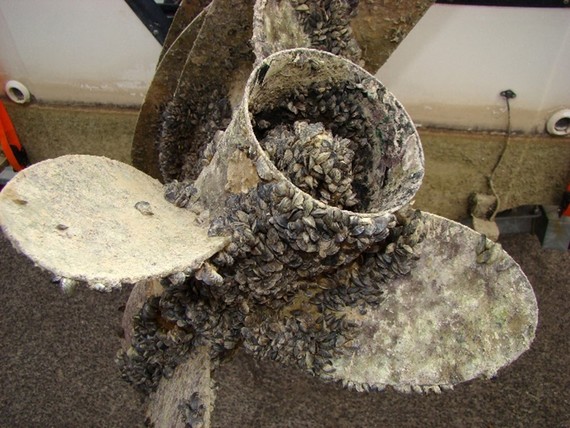 Wild Bulletin, Indiana Department of Natural Resources: As you prepare your boat or recreational equipment to get back on the water this spring, remember to look for aquatic hitchhikers. Zebra mussels, aquatic plants like Eurasian watermilfoil or starry stonewort, and many other invasive species continue to be a threat to Indiana’s waters by degrading fish habitat and negatively affecting recreational boating and fishing. The most common locations where plants, mussels, and animals hitch a ride include:
Wild Bulletin, Indiana Department of Natural Resources: As you prepare your boat or recreational equipment to get back on the water this spring, remember to look for aquatic hitchhikers. Zebra mussels, aquatic plants like Eurasian watermilfoil or starry stonewort, and many other invasive species continue to be a threat to Indiana’s waters by degrading fish habitat and negatively affecting recreational boating and fishing. The most common locations where plants, mussels, and animals hitch a ride include:
- Transom well near the drain plug
- Axle of the trailer
- Lower unit and propeller on the boat motor
- The rollers and bunks that guide the boat onto the trailer
- Anchor and lines
- Bait bucket and live well
Boat owners are asked to drain water from bait buckets, live wells, and boats before leaving the boat landing; leave drain plugs out while travelling on land; clean and dry anything that came in contact with water; and dispose of unwanted bait in the trash. Learn more about aquatic invasive species and how to prevent their movement.
Learn how to stop aquatic hitchhikers.
Find more information about aquatic invasive plants and aquatic invasive invertebrates. Subscribe and receive the Wild Bulletin, Indiana Department of Natural Resources.
Resources:
Invasive plants: Impact on Environment and People, Purdue Extension – Forestry and Natural Resources (FNR)
Report Invasive Species, Purdue Invasive Species
The GLEDN Phone App – Great Lakes Early Detection Network
EDDMaps – Early Detection and Distribution Mapping System
Indiana Department of Natural Resources: Invasive Species
Indiana Invasive Species Council
Cooperative Invasive Species Management Area (CISMA)
Aquatic Invasive Species in the Great Lakes: The Quagga Mussel, Purdue Extension – FNR
Lampreys, Indiana Division of Fish and Wildlife’s Animal Informational Series
Aquatic Invaders in the Marketplace, Illinois-Indiana Sea Grant (IISG)
Great Lakes Sea Grant Network (GLERL), NOAA – Great Lakes Environmental Research Laboratory
Purdue Researchers Get to the Bottom of Another Quagga Mussel Impact, Illinois-Indiana Sea Grant (IISG)
Protect Your Waters, U.S. Fish and Wildlife Service & U.S. Coast Guard
Nongame and Endangered Wildlife, Indiana Department of Natural Resources
Indiana Department of Natural Resources
Purdue Forestry and Natural Resources’ extension efforts over the past two years amidst the COVID-19 pandemic were recognized in the Purdue Extension Specialist Quarterly newsletter.
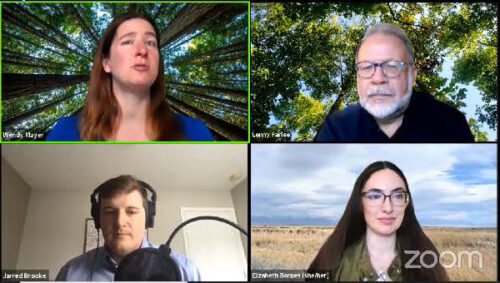 The transition to virtual content brought expertise across subject matter areas, ranging from forestry and wildlife, to aquatic sciences and entomology, to the masses in the form of several video series which collectively earned nearly 150,000 views.
The transition to virtual content brought expertise across subject matter areas, ranging from forestry and wildlife, to aquatic sciences and entomology, to the masses in the form of several video series which collectively earned nearly 150,000 views.
The FNR Extension team included: Jay Beugly, Jarred Brooke, Nick Burgmeier, Barny Dunning, Diana Evans, Lenny Farlee, Jason Hoverman, Liz Jackson, Brian MacGowan, Patrick McGovern, Wendy Mayer, Charlotte Owings, Lindsey Purcell, Bee Redfield, Shelby Royal, Bob Rode, Kara Salazar, Mike Saunders, Amy Shambach, Rod Williams, Mitch Zischke, as well as frequent Entomology contributors: Elizabeth Barnes, Cliff Sadof.
The feature in the fourth quarter newsletter begins:
“While Covid caused limitations on travel and in-person events nationwide, across Indiana, many were spending more time in outdoor recreational activities, hiking, bird-watching, hunting and fishing, or managing natural resources properties. Adjusting to the pandemic, the FNR team created an innovative and team-oriented instruction approach through skill-building in video production with coordinated connection and crosspromotion of resources.
“Forestry and Natural Resources (FNR) faculty, specialists, staff, and students, with invited partners across research and Extension, delivered 45-minute Ask an Expert Facebook Live programs for 35 weeks. Programs covered many FNR specialties: Animals & Insects (bats, bird, cicadas, coyotes, deer, fish, frogs, hellbenders, moles, pollinators, salamanders, snakes, toads, turtles, and wood pests); Plants & Ecosystems (invasive plant species, hardwood ecosystems, native grasses for wildlife, conservation tree planting, rainscaping, fall food plots, and selecting, planting and inspecting trees); and Management & Operations (prescribed fires, aquatic plant and pond management, and fish and wildlife management).
Resources:
Ask An Expert Playlist, Purdue Extension – Forestry and Natural Resources (FNR) YouTube Channel
ID That Tree Playlist, Purdue Extension – FNR YouTube Channel
A Woodland Management Moment Playlist, Purdue Extension – FNR YouTube Channel
Wildlife Habitat Hint Playlist, Purdue Extension – FNR YouTube Channel
Subscribe to the Purdue Extension – Forestry and Natural Resources YouTube Channel
Wendy Mayer, FNR Communications Coordinator
Purdue University Department of Forestry and Natural Resources
Diana Evans, Extension and Web Communication Specialist
Purdue University Department of Forestry and Natural Resources
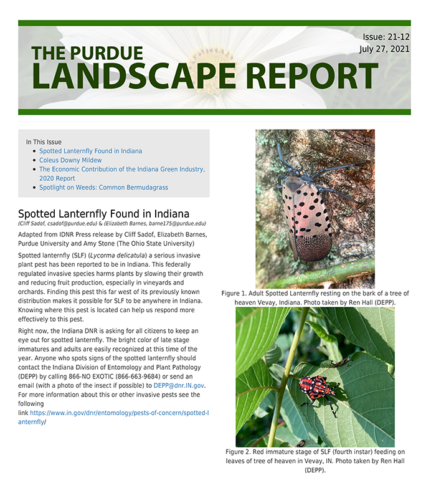 The interdisciplinary faculty and staff behind the Purdue Landscape Report, which provides science-based, timely information regarding Midwest landscapes to commercial growers, garden centers, landscapers, arborists and the general public, has been named as the recipient of the Purdue Agriculture TEAM Award, which was created in 1995 to recognize interdisciplinary team achievements of faculty and staff.
The interdisciplinary faculty and staff behind the Purdue Landscape Report, which provides science-based, timely information regarding Midwest landscapes to commercial growers, garden centers, landscapers, arborists and the general public, has been named as the recipient of the Purdue Agriculture TEAM Award, which was created in 1995 to recognize interdisciplinary team achievements of faculty and staff.Led by Kyle Daniel, nursery and landscape outreach specialist in the Department of Horticulture and Landscape Architecture, the Purdue Landscape Report is a collaborative effort between Purdue Extension specialists and diagnosticians in the departments of Botany and Plant Pathology, Entomology, Forestry and Natural Resources, and Horticulture and Landscape Architecture. Articles cover everything from urban forestry and tree maintenance to pest and disease problems and management to plant selection and turf science. In addition to an email newsletter and online blog, PLR staff also provide live interactive webinars in order to highlight content and respond to questions from the audience.
In response to the pandemic, the Purdue Landscape Report staff also began a live, to addresses articles and hot topics. That series garnered more than 2,000 views.
In a January 2021 survey sent to PLR subscribers, 88% of respondents said they believed that the newsletter improved their ability to diagnose a problem, while 76% said that PLR has had a positive economic impact on their business.
A local professional shared that “Sometimes when I open up the PLR, it is like you have been reading my mind. The problem I have been seeing or thinking about is there in your headlines.”
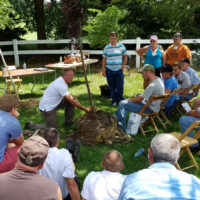 One PLR subscriber said “The Purdue Landscape Report is a great resource for myself and my team members. Within each issue is one or more topics that our team has encountered or discussed recently and the information provided by a very reputable source gives us the material needed to provide the best service to our clients and increase our knowledge base. The virtual sessions are another great resource provided that give an opportunity to have specific questions answered by experts.”
One PLR subscriber said “The Purdue Landscape Report is a great resource for myself and my team members. Within each issue is one or more topics that our team has encountered or discussed recently and the information provided by a very reputable source gives us the material needed to provide the best service to our clients and increase our knowledge base. The virtual sessions are another great resource provided that give an opportunity to have specific questions answered by experts.”
The impact extends from landowners to industry professionals and beyond.
“Often we take for granted the information produced in the PLR and we forget the countless dollars we have saved from information in the PLR,” said Rick Haggard, Indiana Nursery and Landscape Association Executive Director.
“The Purdue Landscape Report provides timely information to the Indiana Arborist Association members and associated parties in a format that is easily accessed and understood,” Associate Executive Director of IAA Ashley Mulis said. “The collaboration that goes into providing this product demonstrates the cohesive nature of several departments within Purdue University and the open sharing and comparison of information. The Purdue Landscape Report is an excellent addition to the many publications offered within Purdue Extension in helping resource professionals manage the ever-changing landscape of pests, diseases and best management practices.”
Resources:
Purdue University Department of Forestry and Natural Resources
Indiana Arborist Association
In this episode of A Woodland Management Moment, Purdue Extension forester Lenny Farlee talks about a variety of hand tools you can use to assist with invasive species control and timber stand improvement on your property if you choose not to use power tools.
If you have any questions regarding trees, forests, wildlife, wood products or other natural resource topics, feel free to contact us by using our Ask an Expert web page.
Resources:
A Woodland Management Moment, Playlist, Purdue Extension – Forestry and Natural Resources (FNR) YouTube Channel
Shrubs and Woody Vines of Indiana and the Midwest, The Education Store, Purdue Extension Resource Center
Native Trees of the Midwest, The Education Store
ID That Tree, Playlist, Purdue Extension – FNR YouTube Channel
Investing in Indiana Woodlands, The Education Store
Woodland Stewardship for Landowners Video Series, Playlist, Indiana Department of Natural Resources YouTube Channel
Lenny Farlee, Sustaining Hardwood Extension Specialist
Purdue University Department of Forestry and Natural Resources
In this episode of A Woodland Management Moment, Purdue Extension forester Lenny Farlee talks about the process of invasive species control in woodland areas from the combination of various treatments methods to the timing of those treatments.
If you have any questions regarding trees, forests, wildlife, wood products or other natural resource topics, feel free to contact us by using our Ask an Expert web page.
Resources:
A Woodland Management Moment, Playlist, Purdue Extension – Forestry and Natural Resources (FNR) Youtube Channel
Invasive Species, FNR Playlist
Report Invasive Species, Purdue Invasive Species
The GLEDN Phone App – Great Lakes Early Detection Network
EDDMaps – Early Detection and Distribution Mapping System
Indiana Department of Natural Resources: Invasive Species
Indiana Invasive Species Council
Cooperative Invasive Species Management Area (CISMA)
Woodland Stewardship for Landowners: Environmental Quality Incentives Program (EQIP) -helping with invasive species
Invasive plants: impact on environment and people, The Education Store
What are invasive species and why should I care?, Got Nature? Blog, Purdue Extension
Woodland Invaders, Got Nature? Blog
Lenny Farlee, Sustaining Hardwood Extension Specialist
Purdue University Department of Forestry and Natural Resources
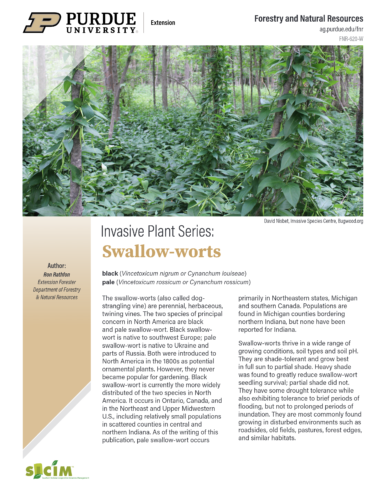 The swallow-worts (also called dogstrangling vine) are perennial, herbaceous, twining vines. The two species of principal concern in North America are black and pale swallow-wort. Black swallowwort is native to southwest Europe; pale swallow-wort is native to Ukraine and parts of Russia. Both were introduced to North America in the 1800s as potential ornamental plants.
The swallow-worts (also called dogstrangling vine) are perennial, herbaceous, twining vines. The two species of principal concern in North America are black and pale swallow-wort. Black swallowwort is native to southwest Europe; pale swallow-wort is native to Ukraine and parts of Russia. Both were introduced to North America in the 1800s as potential ornamental plants.
Although swallow-worts are not yet well established in Indiana, their vines are highly invasive and grow vigorously, quickly twining around, and will climb anything nearby such as trees and shrubs or even man-made structures. This can overwhelm nearby plants by physically shading them, weighing them down, causing stem breakage, and forcing them to compete for moisture and nutrients.
At the time of writing, nine counties in central and northern Indiana reported small populations of black swallow-wort ranging in size from 10 square feet to 2,500 square feet of the infested area. Along Indiana’s border, two Michigan counties and the Chicago area report significant populations of black swallow-wort. No records of pale swallow-wort have been reported for Indiana. Two Michigan counties bordering northern Indiana and a central Illinois county are the nearest reported populations of pale swallow-wort.
This publication, Invasive Plant Series: Swallow-worts, aids in identifying these swallow-worts and provides management recommendations focused on prevention of spread, early detection, and properly timed and targeted control measures.
Resources:
Invasive Species, Playlist, Purdue Extension YouTube Channel
Invasive Plants Threaten Our Forests Part 1: Invasive Plant Species Identification, Webinar, Purdue Extension – Forestry and Natural Resources YouTube Channel
Invasive Plants Threaten Our Forests Part 2: Control and Management, Webinar, Purdue Extension – FNR YouTube Channel
Indiana Invasive Species Council
Report Invasive, Purdue Extension
The GLEDN Phone App – Great Lakes Early Detection Network
EDDMaps – Early Detection and Distribution Mapping System
Indiana Department of Natural Resources: Invasive Species
Indiana Invasive Species Council
Cooperative Invasive Species Management Area (CISMA)
Invasive plants: impact on environment and people, The Education Store, Purdue Extension resource center
Invasive Plant Species Fact Sheets: Poison Hemlock, The Education Store
What are invasive species and why should I care?, Got Nature? Blog, Purdue Extension – Forestry and Natural Resources
Ronald Rathfon, Regional Extension Forester Southern Indiana Purdue Agriculture Center (SIPAC)
Purdue Department of Forestry and Natural Resources
In this episode of A Woodland Management Moment, Purdue Extension forester Lenny Farlee shares about some of the spring ephemeral plants, as well as shrubs, trees and even invasive species you may find in the forest understory.
If you have any questions regarding trees, forests, wildlife, wood products or other natural resource topics, feel free to contact us by using our Ask an Expert web page.
Resources:
A Woodland Management Moment, Playlist, Purdue Extension – Forestry and Natural Resources (FNR) YouTube Channel
Shrubs and Woody Vines of Indiana and the Midwest, The Education Store, Purdue Extension Resource Center
Native Trees of the Midwest, The Education Store
ID That Tree, Playlist, Purdue Extension – FNR YouTube Channel
Invasive Species, Playlist, Purdue Extension – FNR YouTube Channel
Garlic Mustard, Purdue Extension – FNR YouTube Channel
Invasive plants: impact on environment and people, The Education Store, Purdue Extension resource center
Investing in Indiana Woodlands, The Education Store
Forest Improvement Handbook, The Education Store
Woodland Invaders, Got Nature? Blog
Resources and Assistance Available for Planting Hardwood Seedlings, The Education Store
Woodland Stewardship for Landowners Video Series, Playlist, Indiana Department of Natural Resources YouTube Channel
Lenny Farlee, Sustaining Hardwood Extension Specialist
Purdue University Department of Forestry and Natural Resources
Recent Posts
- What Are Invasive Species and Why Should I Care?
Posted: March 25, 2024 in Forestry, How To, Invasive Plant Species, Plants, Woodlands - State of Indiana Proclamation-Invasive Species Week 2024
Posted: February 19, 2024 in Alert, Forestry, Forests and Street Trees, Invasive Animal Species, Invasive Insects, Invasive Plant Species, Urban Forestry, Wildlife, Woodlands - ID That Tree: Native Blackhaw vs. Invasive Winged Burning Bush
Posted: December 8, 2023 in Forestry, Forests and Street Trees, How To, Invasive Plant Species, Plants, Wildlife, Woodlands - Forest Management for the Private Woodland Owner – SIPAC
Posted: November 17, 2023 in Forestry, How To, Invasive Plant Species, Timber Marketing, Woodlands - Now Is The Time To Control Non-Native Bush Honeysuckle
Posted: October 25, 2023 in Forestry, How To, Invasive Plant Species, Woodlands - Cost Assistance for Landowners Planning Conservation Practices
Posted: October 13, 2023 in Forestry, Invasive Plant Species, Natural Resource Planning, Woodlands - Publication: Invasive Plant Series-Tree of Heaven, Ailanthus altissima
Posted: September 12, 2023 in Alert, Forestry, Invasive Plant Species, Plants, Wildlife - IN DNR Division of Entomology & Plant Pathology Shares Kudzu Program
Posted: in Forestry, How To, Invasive Plant Species, Plants, Uncategorized, Wildlife - Tree of Heaven is not so Heavenly-Purdue Landscape Report
Posted: August 9, 2023 in Alert, Forestry, Invasive Plant Species, Wildlife, Woodlands - Question: What is the best treatment to control unwanted trees or brush in woodlands?
Posted: June 13, 2023 in Forestry, How To, Invasive Plant Species, Woodlands
Archives
Categories
- Alert
- Aquaculture/Fish
- Aquatic/Aquaculture Resources
- Ask the Expert
- Christmas Trees
- Community Development
- Disease
- Drought
- Forestry
- Forests and Street Trees
- Gardening
- Got Nature for Kids
- Great Lakes
- How To
- Invasive Animal Species
- Invasive Insects
- Invasive Plant Species
- Land Use
- Natural Resource Planning
- Nature of Teaching
- Plants
- Podcasts
- Ponds
- Publication
- Safety
- Timber Marketing
- Uncategorized
- Urban Forestry
- Webinar
- Wildlife
- Wood Products/Manufacturing
- Woodland Management Moment
- Woodlands
